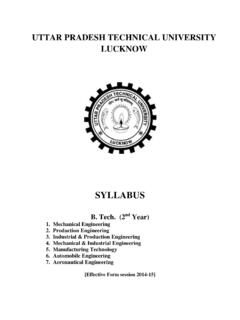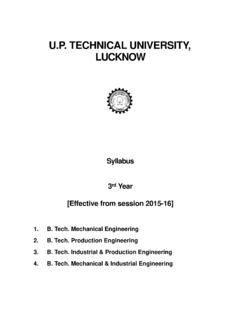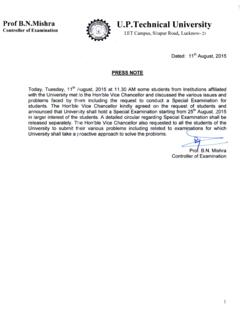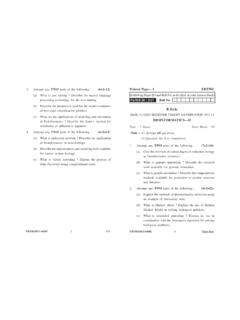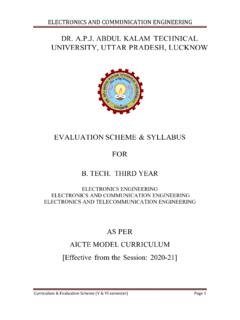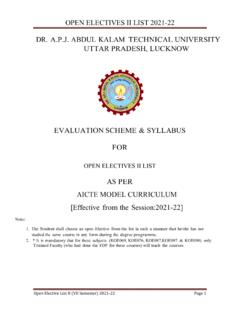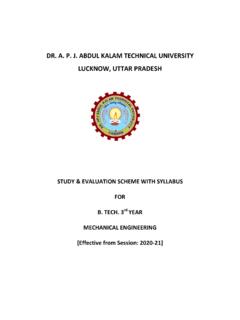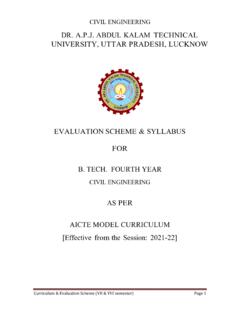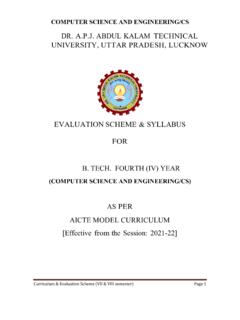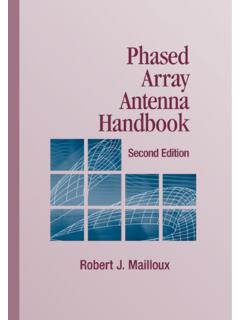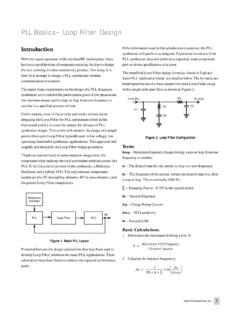Transcription of REVISED OPEN ELECTIVES I (VII SEMESTER)
1 Open Elective I&II 2020-21 CBCS system R series (VII & VIII Semester) Page 1 DR. ABDUL KALAM TECHNICAL UNIVERSITY UTTAR PRADESH, LUCKNOW EVALUATION SCHEME & SYLLABUS FOR REVISED OPEN ELECTIVES I (VII SEMESTER) [Effective from the Session: 2020-21] Open Elective I&II 2020-21 CBCS system R series (VII & VIII Semester) Page 2 VII SEMESTER 2020-21 REVISED OPEN ELECTIVE-I 1. ROE070 HUMAN VALUES IN SANKHAY YOGA AND VEDANTA DARSAN 2. ROE071 MODELLING AND SIMULATION OF DYNAMIC SYSTEMS 3. ROE072 INTRODUCTION TO SMART GRID 4. ROE073 CLOUD COMPUTING 5. ROE074 UNDERSTANDING THE HUMAN BEING COMPREHENSIVELY - HUMAN ASPIRATIONS AND ITS FULFILLMENT 6. ROE075 AUTOMATION AND ROBOTICS 7. ROE076 COMPUTERIZED PROCESS CONTROL 8. ROE077 MODELING OF FIELD-EFFECT NANO DEVICES 9. ROE078 QUALITY MANAGEMENT 10. ROE079 GIS & REMOTE SENSING 11. ROE080 HUMAN VALUES IN BUDDHA AND JAIN DARSHAN Open Elective I&II 2020-21 CBCS system R series (VII & VIII Semester) Page 3 ROE 070 Human Values in Sankhya, Yoga and Vedanta DarshanL 3 T 0 P 0 C 3 Version No.
2 : (updated as on June 12 19) Prerequisite: KVE 301/401- Universal Human Values and Professional Ethics Objectives: 1. To help students understand the basic principles of Sankhya, Yoga and Vedanta Darshan 2. To help students understand the existential realities including the human existence through Sankhya, Yoga and Vedanta Darshan 3. To help them to see the participation of human beings in the nature/ existential realities ( human values) and therefore the human conduct through each one of them 4. To help students apply this understanding to make their living better at different levels-individual, family, society and nature 5. To facilitate the students in applying this understanding in their profession and lead an ethical life Course Outcome: On completion of this course, the students will be able to 1. Understand the basic concepts of Sankhya, Yoga and Vedanta Darshan. 2. Understand the human being, the needs and activities of human being through Sankhya, Yoga and Vedanta Darshan.
3 3. Understand the whole existence 4. Understand the role of human being in the entire existence, thus getting clarity about values at all levels of living and human conduct 5. Understand the foundation of human society and human tradition. Catalogue Description: Sankhya, Yoga and Vedanta Darshan form a part of the philosophy of Indian tradition. This course outlines the basic concepts and principles of these three philosophies and provides scope for further reading of the philosophies, so as to gain clarity about the human being, the existence and human participation human values expressing itself in human conduct. It is to be kept in mind that Darshan means realisation which calls for developing the capacity to see the reality in oneself directly. So, any study of Darshan shall help develop this capacity in the students through proper steps of practices and shall not just provide the information.
4 Module I :Introduction to Sankhya, Yoga and Vedanta Darshan and their Basics Need to study Sankhya, Yoga and Vedanta Darshan; the origin of the three philosophies, their basic principles and scope for further reading. Module II: Sankhya Darshan Sankhya Darshan- the nature of Purush and Prakriti, 8 types of prakriti (pradhan, mahattatva, ahankar and five tanmatras- sound, touch, form, taste and smell) and their 16 evolutes (vicar); pramana (pratyaksha, anumana and agama), bondage and salvation (liberation), the principle of satkaryavad, sense organs, work organs, trigunatmak prakriti Open Elective I&II 2020-21 CBCS system R series (VII & VIII Semester) Page 4 Module III: YogaDarshan Yoga Darshan- the steps of Ashtanga yoga (yama, niyama,aasana, pranayama, pratyahara, dharana, dhyan and samadhi) and the challenges in following them, afflictions (klesha)-avidya, asmita, raga, dvesha, abhinivesh, different types of vritti (pramana, viparyaya, vikalp, nidra, smriti), the process of nirodha of vritti; maitri, karuna, mudita, upeksha;description of yama, niyama, aasana and pranayaama.
5 Kriyayoga tapa, swadhyaya and ishwar-pranidhana, different steps of samadhi, different types of sanyama, vivekakhyati, pragya. Module IV :Vedanta Darshan Vedanta Darshan- Nature of Brahma and Prakriti, Methods of Upasana; adhyasa and sanskar; nature of Atma, description of existence, principle of karma-phala, description of pancha kosha, different nature of paramatma/brahma, Ishwar, Four qualifications (Sadhan-chatushtay). Module V : Purpose and Program for a Human Being based on the Three Darshan The purpose and program of a human being living on the basis of the three darshanas, clarity and practice of human values and human conduct, the natural outcome of such a program on society, nature and tradition. possibility of finding solutions to present day problems in the light of it. Text Books: 1. Chattejee, and Datta, , An Introduction to Indian Philosophy , University of Calcutta Press, 1960. References: 1.
6 Goendaka, J., Shreemad Bhagwat Geeta , Geeta Press, Gorakhpur, 73rd reprint, 2015. 2. Krishna, I., The Sankhya Karika , Bharatiya Vidya Prakashan, 4th edition, 2010. 3. Madhavacharya, Sarva-darshan Samgraha , Chaukhambha Vidya Bhavan, Varanasi, 1984. 4. Maharaj, O. Patanjal Yog Pradeep , Geeta press, Gorakhpur, 30th reprint, 2009. 5. Muller, The Six Systems of Indian Philosophy , Longmans Green and Co. Publication, London, 1928. 6. Radhakrishnan, S., Indian Philosophy (Volume 1 and 2) , Oxford University Press, 2nd edition, 1996. 7. Shankaracharya, Vivek Choodamani , Geeta Press, Gorakhpur, 48th Reprint, 2018. 8. Sivananda, S., Raj Yoga , The Divine Life Society, Rishikesh, 7th edition, 2016. 9. Vachaspati, M., Sankhya Tatva Kaumudi , Motilal Banarasi Das Publication, Varanasi, 1921. Mode of Evaluation: Assignment/ Seminar/Continuous Assessment Test/Semester End Exam Open Elective I&II 2020-21 CBCS system R series (VII & VIII Semester) Page 5 ROE-071 MODELLING AND SIMULATION OF DYNAMIC SYSTEMS COURSE OBJECTIVE: Students undergoing this course are expected to- 1.
7 Define, describe and apply basic concepts related to modeling and simulation. 2. Use conservation laws and constitutive relationships and other physical relations to model mechanical, electrical and flow systems, and combinations of these. COURSE OUTCOME: After completion of the course student will be able to- CO1: Define, describe and apply basic concepts related to modeling and simulation. CO2: Construct bond graphs for the type of systems mentioned above, simplify and analyze the bond graph according to causality conflicts. CO3: Use conservation laws and constitutive relationships and other physical relations to model mechanical, electrical and flow systems. CO4: Find dynamic response and transfer function using various tools for system modeling. CO5: Model and simulate mechanical and electrical systems using the computer tools Simulink. ROE-071 MODELLING AND SIMULATION OF DYNAMIC SYSTEMS Unit Topic Lectures 1 Introduction to modeling and simulation: Introduction to modeling, Examples of models, modeling of dynamic system , Introduction to simulation, MATLAB as a simulation tool, Bond graph modeling, causality, generation of system equations.
8 8 2 Bond graph modeling of dynamic system : Methods of drawing bond graph model- Mechanical systems & Electrical systems, some basic system models- Mechanical systems, Thermal systems, hydraulic systems, pneumatic systems and electrical systems. 8 3 system models of combined systems: Linearity and non linearity in systems combined rotary and translatory system , electro mechanical system , hydro- mechanical system . 8 4 Dynamic Response and system Transfer Function: Dynamic response of 1st order system and 2nd order system , performance measures for 2nd order system , system transfer function, transfer function of 1st and 2nd order system Block diagram algebra, signal flow diagram, state variable formulation, frequency response and bode plots. 8 5 Simulation and simulation applications: Simulation using SIMULINK, examples of simulation problems- simple and the compound pendulum, planner mechanisms, validation and verification of the simulation model, parameter estimation methods, system identifications, introduction to optimization.
9 8 Text Books and References: 1. Zeigler Praehofer. H. and Kim "Theory of modeling and simulation", 2nd Edition. Academic press 2000. 2. Robert L. Woods, Kent L. Lawrence, Modeling and simulation of dynamic systems , Person, 1997. 3. Brown, Forbes T. Engineering system Dynamics , New York, NY: CRC, 2001. ISBN: 9780824706166. 4. " Getting started with MATLAB" Oxford university Press 2009. Open Elective I&II 2020-21 CBCS system R series (VII & VIII Semester) Page 6 ROE-072 INTRODUCTION TO SMART GRID COURSE OBJECTIVE: Students undergoing this course are expected to- 1. Present the fundamental concepts associated with Smart Grids. 2. Review renewable energy generation, grid integration energy storage technologies and future developments 3. Introduce advanced management and control concepts of Smart Grids. COURSE OUTCOME: After completion of the course student will be able to- CO1: Identify the key elements of Smart Grids and visualize the roadmap towards next-Gen electricity networks.
10 CO2: Evaluate technology options pertaining to renewable energy generation, energy storage, data handling and communications for Smart Grids. CO3: Justify technological and economical choices in the context of existing commercial Smart Grids projects. CO4: Determine the relevance of Smart Grids projects, develop ways to evaluate their impacts and implications. CO5: Analyse the new roles of utilities and consumers in Smart Grids. ROE-072 INTRODUCTION TO SMART GRID Unit Topic Lectures 1 Introduction: Introduction to Smart Grid: Evolution of Electric Grid, Concept of Smart Grid, Definitions, Need of Smart Grid, Functions of Smart Grid, Opportunities & Barriers of Smart Grid, Difference between conventional & smart grid, Concept of Resilient & Self Healing Grid, Present development & International policies in Smart Grid. Case study of Smart Grid. CDM opportunities in Smart Grid. 8 2 Smart Grid Technologies: Introduction to Smart Meters, Real Time Prizing, Smart Appliances, Automatic Meter Reading (AMR), Outage Management system (OMS), Plug in Hybrid Electric Vehicles (PHEV), Vehicle to Grid, Smart Sensors, Home & Building Automation.
